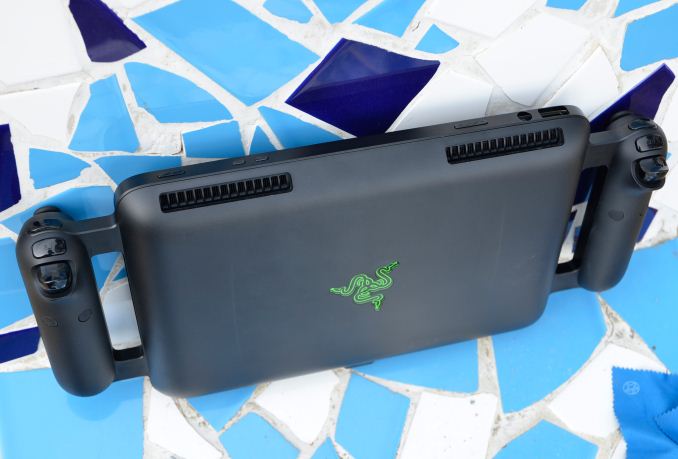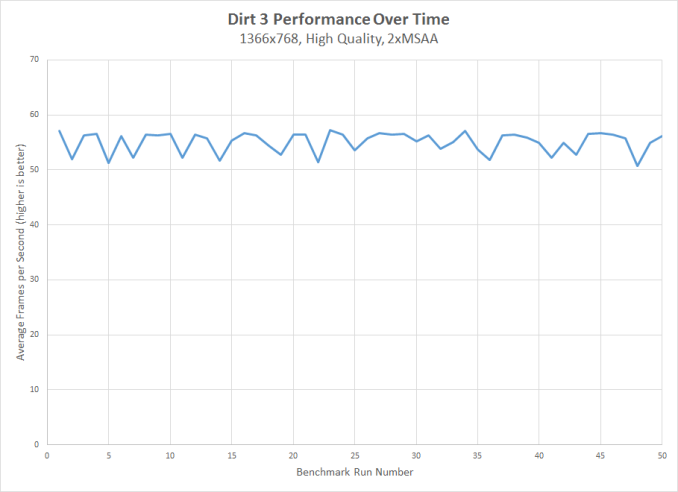The Razer Edge Review
by Vivek Gowri on March 28, 2013 11:00 AM EST- Posted in
- Tablets
- Mobile
- Razer
- Razer Edge
Thermals
The thermal story here is pretty interesting. Obviously, with a huge thermal envelope for such a small form factor, the first concern I had was for heat. Razer has a fair bit of experience shoving a lot of hardware in tight spaces, though with the Blade the problem construction was different. The Blade chassis is very thin, but has a lot of room in terms of footprint. The sheer amount of surface area top and bottom, as well as all the venting on the bottom and sides, help the Blade (especially the 2nd generation one) effectively cool itself even though there’s relatively little volume available.
The Edge, by comparison, has a tiny footprint and hence needs to be much thicker than competing tablets; it’s actually also thicker than the bottom casing of the Blade, so there’s that too. Airflow is extremely key here, since there’s very little surface area to let heat dissipate convectively. The heat pipe, too, is key, as tablets have far more orientations that need to be designed for when compared to notebooks. Orientation matters for heat pipes, as their effectiveness depends on how much working fluid can be transported from the condenser to the evaporator. Operating against gravity is always a losing proposition, and as such there’s an inverse correlation between transport capacity and operation against gravity (ie, as the angle of operation against gravity increases, the transport capacity of the heat pipes typically decrease.)
At some point in the future I’ll do a much more thorough article on how heat pipes and the cooling systems in mobile computers work, but for now this will have to suffice. The TL;DR version as pertinent to this article: if you have enough compute horsepower in a tablet to require active cooling, you’re in for a hell of a time. Tablets are much harder to cool actively than notebooks.
Which is why thermal performance was, for me at least, the major concern with the Edge prior to launch. The 0.8” thickness helped alleviate my fears somewhat, because that gets you a significant amount of volume to work with compared to something like the Surface Pro. Ivy Bridge ULV and Kepler are also pretty good as far as thermal performance goes, so I wasn’t concerned at all about how it would behave under light usage cases, particularly ones that didn’t have the GPU turning on. But when the system is stressed, what then?
To find out, I fired up my 100% system load test – Furmark 1080p and wPrime 1024M (4 threads) looping, which maxes CPU and GPU – and let it run for a sustained period of time. I saw GPU temps hit 85C with ease, while CPU got up to 95C. The GPU temperature stabilizes in the 87F region at 0.887V (the voltage at 500MHz). CPU temp stabilizes in the low 90s, which is interesting because we typically see CPU temperatures that are lower than the GPU temps. CPU power draw hovers around 14.7W when both cores are loaded. The Edge reaches thermal equilibrium before it starts throttling the GPU, which is a good sign.
I also ran my real-world gaming situation with the Dirt 3 benchmark, and like last time, ran it 50 times in a row, this time on high settings with 2xMSAA at 1366x768, my graphics setup of choice for playing the game when the Edge was plugged in. The results were pretty interesting – while average framerates stayed in the 52-56 fps range for a majority of the tests, the minimum framerate told a good bit of the story. There are three primary speeds and voltages the GPU runs at: the default 500MHz (0.887V), 570MHz (0.912V), and 405MHz (0.813V). In many of the runs in the 55-57fps range, the minimum framerate would be around 45-46fps, while some of the runs that had average fps on the low end (51-52fps), the minimum framerate would be below 40, sometimes as low as 35 fps. This happened every three or four runs, with consistency, with the GPU clocking down to the lower voltage performance state when necessary in order to maintain thermal equilibrium. At no point was there an extended period of throttling, which is why performance remained mostly constant for the roughly two and a half hours it took to go through 50 runs of the benchmark. That’s pretty impressive, considering the amount of thermal stress the GPU puts on a system of this size.












89 Comments
View All Comments
kyuu - Friday, March 29, 2013 - link
Because Razer operates on large profit margins, and judging by the Blade and this thing, I'm pretty sure they don't really have any interest in putting out cheap "me-too" platforms. They're more interested in pushing innovative platforms and don't need or expect to move large volumes of the product.B3an - Friday, March 29, 2013 - link
The Vita isn't a full PC with a real OS and Ultrabook level hardware with a game library anywhere near as big as Windows. Stupid comparison.Jumangi - Friday, March 29, 2013 - link
Lolz, this is designed fist as a portable gaming device even though it makes every compromise you can. its price its stupid high, and it looks plain goofy. This thing is stupid and has no place in the market. It sits right up there with the N-gage in the history of dumb gaming devices.Visual - Friday, March 29, 2013 - link
How can you not include IVB integrated results in the games charts? What is wrong with you? That is the ONLY important test that needs to be done to the Edge - is it worth the cost and added bulk over integrated or is it not...Also, saying Civ V is not playable is ridiculous. You did something wrong in the testing. It was playable on my ancient HP tm2 tablet, and that is worse than even the IVB integrated GPU. With the Edge it should be a ton better.
NeedsAbetterChair - Friday, March 29, 2013 - link
I really do love the idea of this but it is obvious to me I'll have to wait a year of two for this category to mature. The next few years are going to be interesting.Hrel - Friday, March 29, 2013 - link
Once again their first attempt is not viable. At 1000 dollars I'd like to see a higher resolution screen, 1600x900 at least. I realize the gpu can't take it, but you can run games at 720p and you'll be fine. Resolution comes down to screen real estate. I need more than 768 vertical pixels. Especially at $1000!!! Furthermore I agree a 64GB SSD is almost useless. 128 should be the entry point with a 256 and maybe a 380 option. I know they can get 256GB SSD's for 150, probably less if they buy in bulk.The thickness of the screen bezel makes me feel like it belongs in the late 90's/early 2000's. Expand the screen .4 to .6 inches and keep the same chassis with a smaller bezel.
I see no value from the i7 "upgrade" and don't want to be forced into it just to get a reasonably sized SSD.
Hrel - Friday, March 29, 2013 - link
On the controller, maybe try moving ab xy to the back, so they line up with you ring and middle fingers? Not sure how well this would work as I've never used anything like it.Shadowmaster625 - Friday, March 29, 2013 - link
Can they get any more stupid? They just trashed any hope of any future for this brand name. This is way way waaaaay too much money to pay for something that gives you such a small boost compared to a bargain bin AMD A10 notebook. They should have just waited for Richland and made a deal with AMD. They could have gotten about the same gaming performance, with 50% better battery life and $400+ cut from the price tag. They could have brought us something decent without the outrageous price that is going to make most people laugh and never look at this brand again. People commenting on facebook and twitter are just morons. It is easy for people to say they want all these things from a product, but it doesnt mean they are actually going to buy what they claim they want.anubis44 - Friday, March 29, 2013 - link
They should use an AMD Jaguar for this. Only an AMD APU will provide the kind of low power consumption and great GPU performance stuffed into a 15w power envelope. Jaguar's GPU destroys the GT640.Silma - Friday, March 29, 2013 - link
So basically this is a tablet thicker than an Ultrabook, with less i/o ports than an Ultrabook, and overpriced gamepad that make it wider than a 17" gamining laptop, all for the pleasure of playing at 1368 resolution?No thanks I'll keep my Alienware notebook. For gimmicky games at low resolution I have a phone.